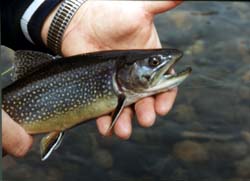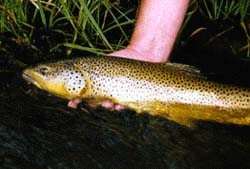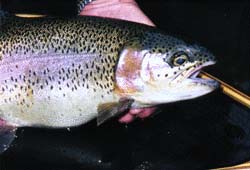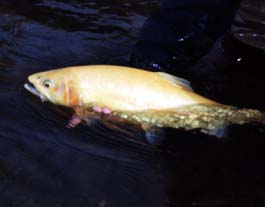He was gliding on airy wings, and ever so effortlessly to a nearby spruce tree. The common grackle, a familiar iridescent blackbird with a long, almost boat shaped tail. Bathed in evening sunlight, shining greens and purples on his black plumage, he blinks curiously with his big yellow eyes, and tiny black pupils.
Suddenly, he lets out a cry, throwing his backward into the air, but keeping a firm grip on the wavering branch all the while. The sound emitted is the bird equivelent to a rusty hinge, but far more pleasant. Again he calls, throat feathers flared, he is appearantly trying to find love. When he sees it's not there, he zips off into the air, and glides to another tree where he yet again sings his metallic, underrated song.
---
Meanwhile, at the pond just a couple hundred yards away, I do a little more people watching than I originally intended!
Word has spread of the stocking of Reservoir Pond, and while I was one of the first to discover this, the pond borders have been overrun with fair-weather fish fans, feeding the fish as fishing is off limits until the 15th of April.
I'm perturbed!
I guess it's okay to share, but when large groups of people gather, what you often end up having is a bunch of know-it-alls, who in fact know little or nothing about what the hell they're looking at! The NO FISHING signs have been torn down, tossed in the pond, and I sighed angrily as I took note of a burger king cup poised on the edge of the pond wall, just inches away from falling onto the precious fish below.
I noticed a few girls sitting on the stone wall, tossing crackers and bread crumbs into the water. Suddenly, a feeding frenzy ensued, and the water surface erupted into flopping tails and snapping trout jaws!
I notice that two of the trout were golden-yellow palamino rainbow trout. (A now widely bred rainbow trout hatchery mutation.) Elegant, and popular among the young ones, they were two of the largest trout I could see. One seemed to exceed 18 inches, and the other was darn close!
Like orangey torpedos they cruised the water, exploding into a burst of speed each time a piece of something would cause a ripple on the water surface. They'd bulley their way through the school of smaller trout like nobodies business.
---
Trout Hatcheries are a blessing. Millions of trout fisherman take to the streams, ponds, and lakes across the world each year in search of trout. The majority of which fish only for the first week of the season before retiring their barely-used rods into the closet for another year.
If it weren't for our trout hatcheries raising billions of trout each year for release, the sport would probably flop and gasp for oxygen just like the quarry at hand! They raise them, then dump them into various designated streams, rivers, lakes or ponds each year to ensure that the native fish population isn't exhausted.
The downside to this is that it is like any other mass produced product; there is a sincere lack of quality behind the fish produced.
Hatchery fish definitely become wary over time, but in the weeks upon their stocking they are hungry, and eager to bite at just about anything floating around in the water! They're perfect for clumsy elderlies, novices, and children to catch. With that said, they aren't the dumbest fish either! Some are quickly educated, and become as wary as the stream born fish.
Of the 90 some fish I caught on the first Saturday after April 15th last year, I would say that around 75% of those fish were hatchery raised fish. The other 25% were stream born natives, much wiser and skittish than their undereducated cohorts.
Yet another downside to hatchery fish are the mutations, and diseases caused by rearing so many trout in such a close area.
As I stood at the pond edge, my polarized glasses allowed me to see under the glare on the water surface. I noticed that one of the trout had stumpy fins, another had a tail with a bite out of it, and another had no tail fins at all! Some had noses grinded flat from feeding on the bottom...meanwhile others seemed in perfect condition. Strange.
Lest I forget the Palamino mutation! I believe it was first discovered in a West Virginia hatchery, and then bred as a popular addition to hatcheries globally. (I can't speak for the world really...but definitely the USA.)
In any case, I did NOT take the following pictures, but I thought I'd show you exactly what trout one might encounter here in Pennsylvania.
The above fish, is not a TRUE trout, but rather a "char". It is the state fish of Pennsylvania, and is (I believe) the only native member of the salmonoid family to have lived and bred here without the aid of human introduction. The line between char and trout is so fine, that they can breed together. Both members of the salmonoid family, male brook trout are some of the most beautiful fish in our state, with flaming orange fins, and colorful spots. One difference that seperates a "char" from a "trout" is the fact that a char has LIGHT spots on a DARKER body. Meanwhile, a true trout has spots that are dark, on a light body. Also, some differences in tooth structure occur, but even so, char and trout hybridize from time to time.
He is a splendid little creature, sometimes living in streams so small that his growth can be stunted to 6 inches. But speaking from experience, a 6 inch "brookie" hits a lure with the same voracity as a 23 inch brown trout. I caught a hatchery brook trout last spring that was 16.5 inches in length, and another that was 15 inches. Both were hatchery-bred females. It would be unrealistic to catch a wild brook trout of that size in the stream I was fishing. (There are some large brook trout in Canada though!) In our wild trout streams, it's rare to catch one over 13 inches.
Aside from the wild fish, this species is raised along side the rest in hatcheries to suppliment trout streams during times of overfishing.
Oh yes, the good ol'Brown Trout! Extremely variable in coloration, and spot structure, the brown trout was introduced to the US from Germany and Scotland back in the 1800's. So similar is the habitat here in central Pennsylvania to that of Western Europe, that the trout has found little problem thriving in our waters!
One of my personal favorites (even though it's a foreigner), the brown trout is a voracious predator who will attack mice who have misplaced their footing on the streamside. Unlike brook trout who prefer small streams, the brown trout is highly adaptable, and can not only exist in smallish streams, but also deep lakes. After numerous years of stocking, the brown trout has made most of our trout streams home, breeding autumn after autumn with no trouble at all, thriving on it's own.
Brownies are georgous yellowey trout, which I am happy to have breeding alongside the brookies in our streams. Sometimes breeding TOGETHER to create the 1 in 6000 chance of catching a TIGER TROUT. I've caught ONE of these brown/brook trout hybrids in my life, and while I feel it was a native stream born fish, I've learned that some of the hatcheries purposely bred some to make things interesting for positive TROUT ID on our Pennsylvanian streams. Now I'm wondering if it WAS wild? I think it was due to it's small size...but we'll see if I can catch him again this year for positive ID.
It is the quitessential trout.
Chances are when you hear me speak of a "trout", this is the fish you think of! Globally introduced, and one of the most popular freshwater game fish in the world, it is unleashed by the millions into streams across the USA.
A western trout, the rainbow has very pacific tendencies, and has only been able to survive on it's own breeding in a HANDFUL of Pennsylvania trout streams. This is because it is a spring breeder, unlike the previous two trout. The water temperatures are just not suitable for the rainbow to breed in the streams I fish.
The colors vary from deep greens and maroon sides, to silvery fish with pink sides. All are extremely fun though, as the rainbow trout is a powerful jumper, known for it's arial maneuvers.
Like the brown trout, they prefer larger streams, with "trophy class" individuals being over 18 inches. Sea/lake run rainbows earn themselves the name "Steelhead", and grow to massive salmon-like sizes. Those particular individuals make an 18 incher look like a youngster!
Here in Pennsylvania, one of our only successfully introduced rainbow streams is in Erie, where the rainbows swim in from Lake Erie to spawn in our streams. These guys are huge, and would undoubtedly snap my 4 lb line without even thinking about it. The other streams that maintain wild rainbows successfully tend to have small individuals, under 12 inches.
However, due to popular demand, these fish are restocked annually into our lakes and streams to suppliment fisherman with a bounty of pink-sided joy each year. The individuals that survive in the years to come will become wary, and cautious, just as if it was born in the stream along side our native brookies and wild browns.
No, it's not a goldfish! It's a golden phase rainbow trout. I'm not sure that this fish has thrived at all in the wild, but I do know that they have learned that their bright coloration makes them an easy target!
Believe it or not, I think I've only ever caught one -- even though hundreds are released into various streams across the stage annually. Any time you see this fish, it's a stocked fish. But I find that if you can see it, you can't catch it! And so most often, I haven't been rewarded with a strike by one of these genetic mutations.
To be honest, last year I didn't see even one on the trout stream I fish, explaining why I haven't caught one.
Well...that's all for tonight. I hope you learned something new!
Monday, April 03, 2006
Daily Musings, & Trout ID 101
Posted by
Michael
at
2:07 AM
![]()
Subscribe to:
Comment Feed (RSS)




|